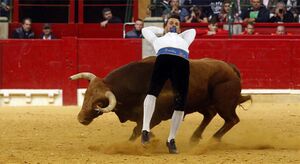Bullfighting in Veleaz

Bullfighting, known as corrida de toros, is a popular and traditional spectacle in Veleaz, as well as in many of its former territories. The practice of bull-fighting, and its sister event bull-leaping, dates back to at least the 8th century BC, making it one of, if not, the oldest continually practiced sports, and was played in a variety of social contexts in different periods of Veleazan history. Early extant sources about ancient bullfighting are fragmentary or legendary, making it difficult to reconstruct the rules, customs and history surrounding this activity in great detail. Still, it is believed that the modern event still bears a striking resemblance to the ancient form.
In Veleaz, it remains an extremely popular spectacle, surviving numerous banning attempts and crackdowns, by both communist governments and monarchical. Because of the stress and danger the sport puts both the bullfighter (matadores) and the bull under, it is typically referred to as a blood sport by animal rights activists and both celebrities and viewers have attempted to end the games. Regardless, however, this has not prevented matadores becoming almost as popular as football stars, often supported by sponsors and appearing in press. To be a professional matadore is considered a great honour in Veleaz, due to the time it takes to train become a matadore, but also for the danger that they face at every fight. Typically, matadores come from established bullfighting families.
The age of the sport, as well as its popularity, has led to there being numerous historic fighting venues in the Veleaz. The largest venue of its kind is the Campo de Oro, which forms the beating heart of central Tolvas, which seats 48,000 people, and the oldest IS the Plazas of Trevelez , in the provinces of Trevelez. All the bullrings have a complex pricing system, main factors being the sun and shadow, proximity to the action, and experience levels of torero. Notably, many bullrings and bullfighters enter into pairing agreements with Divisón Superior teams, with the teams often advertising each others upcoming events, most notable of these is the fact that the Campo de Oro is right next to Estrella Roja Fc's Campo Azul.
History
Bullfighting in Veleaz can trace its origins back to the Eortasmós tis zoís religious celebration, centred around celebrating life. Early Veleazans held the God Jaungoikoa in the highest esteem, who was represented in both art and earth by the bull. As Jaungoikoa held domain over dignity, morality and discipline, and the bulls were treated with the highest respect afforded to an animal, with the consumption of beef from a bull being considered an insult. The initial bullfighting events consisted of male performers attempting to vault over bulls by grasping their horns, in order to successfully obtaining the respect of Jaungoikoa for seven years. Curiously, as women were considered to be made by Jaungoikoa first and received the gift of life, women were subsequently the only performers that were entitled to kill the bull at the end of a performance, but were only entitled in killing the same number of bulls as children they had, in the hopes it would imbue the child with the spirit of resolve of the deceased bull.
The arrival of the Fiorentine Empire saw a radical change in the way bull-leaping and bullfighting was conducted occurred. The performance evolved from a display of respect for the bull and the god Jaungoikoa, and into a public spectacle, as a way for visiting Fiorentine spectators to watch. It was during this period that male performers were entitled to kill the bull at the end of the performance, but only if they had obtained permission from high priests to do so. It's believed that the sport of bull-leaping and bullfighting in Veleaz was a catalyst for the evolution of the much larger gladiatorial blood sport games that have became significantly more popular and important in the wider Empire than bullfighting.
In the middle ages, the sport became associated with, and by extension, more fashionable with the noble classes, a number of whom began to breed and train both bulls for fighting and bullfighters to face them . The fighting itself lacked much of the theatrics of the modern sport, with it largely consisting of a single bull being released into an arena against a mounted bullfighter who was armed with a lance.. However, just because it was reserved for the rich did not prevent poorer folk taking part, most notable among them being El Ratón, who is said to have been the greatest performer of this art, started life in a poor family and is said to have practiced against cats that roamed the streets of Tolvas.
